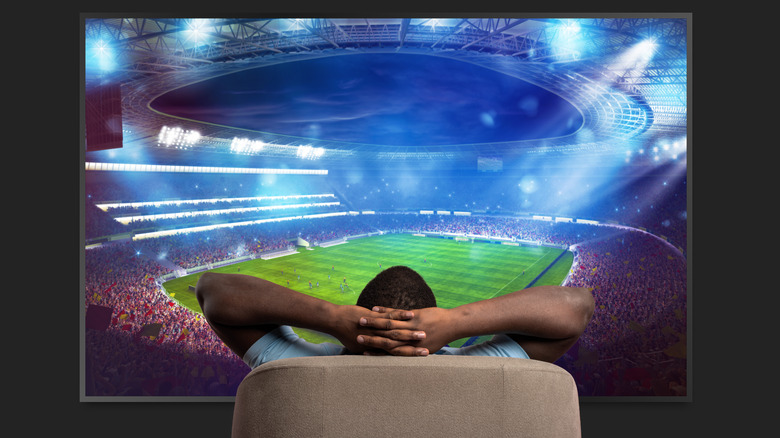Pros & Cons: Do You Really Need A 100-Inch TV?
Whether you're watching a TV series, a movie, a sports game, or playing video games, larger TVs generally provide a better experience. This has prompted TV manufacturers to gradually increase the size of TVs over the years. TVs haven't gotten quite absurd enough to warrant the Ian Malcolm quote, "Your scientists were so preoccupied with whether they could, they didn't stop to think if they should," but it's getting close.
LG Philips developed the first 100-inch TV in 2006. However, Sony, Hisense, Samsung, and the other major TV manufacturers didn't start mass-producing them until 2022, giving consumers nearly two decades to comprehend exactly how large that really is for a TV. At this point, it's not even reasonable to think that a 100-inch display will find a spot in every household. It's not exactly in an accessible price range for the majority, nor do most people have the wall space.
The better question is whether people need a TV as large as that at all. As every responsible person does to determine whether they should make a large purchase, create a list of pros and cons to make the decision process easier. Here are a few things to consider before renting a U-Haul to get the TV home.
Pros of owning a 100-inch TV
Naturally, the bigger the TV, the better the visual. Not necessarily the quality, since that comes down to the resolution, but most TVs these days aren't worse than 720p. With a 100-inch television sitting in your living room, or wherever you decide to put it, you won't need to go to the Super Bowl to experience the game or the movie theater for a full cinematic experience. Something as large as Samsung's 110-inch MicroLED TV is going to make you feel like you're there, especially once you adjust the settings you need to change after buying a new TV.
For those who use a TV for gaming, there won't be an angle you can't see on a 100-inch TV. Whether you're sniping in "Call of Duty," flying a chopper in "Battlefield," or waiting to take out the last opponent in "Fortnight," anybody with a TV this large will see the field more clearly. If there's the slightest movement, they'll notice it. A TV of this caliber doesn't require users to sit as close as they might have to for smaller ones.
If you're hosting a get-together where the TV is on, there's less of a chance that somebody will be in the way. Naturally, you don't want somebody standing in front of you, but if they're seated, they're probably not obstructing much. You can be in another room and enjoy whatever is playing on the TV.
The downside you should consider
The biggest drawback of a 100-inch TV is the cost. You can find a decent television that's half the size for a few hundred dollars. Investing in something as large as 100 inches, though, is going to cost you a pretty penny. A 50-inch television on Amazon can cost as low as $230. That price tag may vary, depending on the specs you're looking for, such as high resolution and frame rate. But $230 is a reasonable price. Even a 70-inch TV will run you about $1,000. There are plenty of budget 4K TVs that won't break the bank. If you're set on a TV around 100 inches, though, it may be close to a $7,000 investment.
Most people might not realize exactly how large 100 inches is for a television. A TV that size will take up a considerable amount of real estate. Before you click the checkout button, you better have measured a safe spot. You either need a TV stand wide and sturdy enough to support such a behemoth of a television, or enough wall space to accommodate it. If you're wall-mounting it, you need a large wall-mount, which adds to the overall cost of the TV. Making sure it's secure in the wall is paramount because you don't want it to fall and shatter in the middle of rewatching "Breaking Bad."
Furthermore, how are you getting the TV home? Or through the front door? Of course, the choice is ultimately up to you. This is all just some food for thought.

